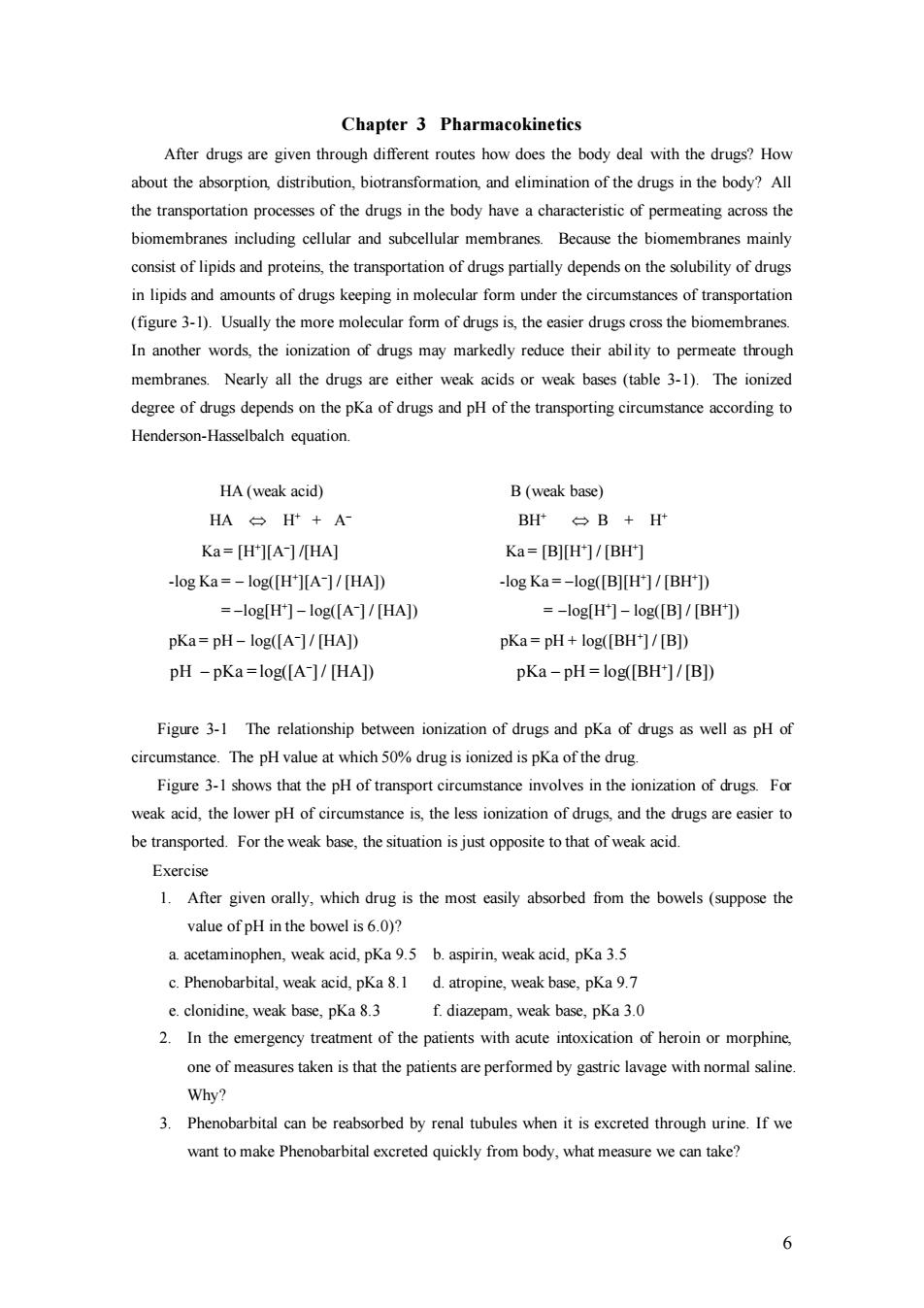
Chapter 3 Pharmacokinetics After drugs are given through different routes how does the body deal with the drugs?How about the absorption distribution,biotransformtion and elimination of the drugs in the body?All the transportation processes of the drugs in the body have a characteristic of permeating across the biomembranes including cellular and subcellular membranes.Because the biomembranes mainly consist of lipids and proteins,the transportation of drugs partially depends on the solubility of drugs in lipids and amounts of drugs keeping in form under the circumstances of transportation (figure 3-1).Usually the more molecular form of drugs is,the easier drugs cross the biomembranes. In another words,the ionization of drugs may markedly reduce their ability to permeate through membranes.Nearly all the drugs are either weak acids or weak bases (table 3-1).The ionized degree of drugs depends on the pKa of drugs and pH of the transporting circumstance according to Henderson-Hasselbalch equation. HA (weak acid) B(weak base) HA台H+A BH÷B+H Ka=[H']A-]/THA] Ka=BH]/BH的 -log Ka=-log([H][A-]/[HA]) -logKa=-log([B][H]/[BH']) =-log[H']-log([A-]/[HAJ) =-log[H*]-log([B]/[BH"]) pKa=pH-log([A-]/[HA]) pKa=pH+log([BH]/[B]) pH -pKa=log([A-]/[HA]) pKa-pH=log([BH+]/[B]) Figure 3-1 The relationship between ionization of drugs and pKa of drugs as well as pH of circumstance.The pH value at which 50%drug is ionized is pKa of the drug Figure 3-1 shows that the pH of transport circumstance involves in the ionization of drugs.For weak acid,the lower pH of circumstance is,the less ionization of drugs,and the drugs are easier to be transported.For the weak base,the situation is just opposite to that of weak acid. Exercise 1.After given orally,which drug is the most easily absorbed from the bowels(suppose the value of pH in the bowel is6.0)? a.acetaminophen,weak acid,pKa 9.5 b.aspirin,weak acid,pKa3.5 c.Phenobarbital,weak acid,pKa8.1 d.atropine,weak base,pKa9.7 e.clonidine,weak base,pKa 8.3 f.diazepam,weak base,pKa3.0 2.In the emergency treatment of the patients with acute intoxication of heroinor morphine one of measures taken is that the patients are performed by gastric lavage with normal saline Why? 3.Phenobarbital can be reabsorbed by renal tubules when it is excreted through urine.If we want to make Phenobarbital excreted quickly from body,what measure we can take? 6
6 Chapter 3 Pharmacokinetics After drugs are given through different routes how does the body deal with the drugs? How about the absorption, distribution, biotransformation, and elimination of the drugs in the body? All the transportation processes of the drugs in the body have a characteristic of permeating across the biomembranes including cellular and subcellular membranes. Because the biomembranes mainly consist of lipids and proteins, the transportation of drugs partially depends on the solubility of drugs in lipids and amounts of drugs keeping in molecular form under the circumstances of transportation (figure 3-1). Usually the more molecular form of drugs is, the easier drugs cross the biomembranes. In another words, the ionization of drugs may markedly reduce their ability to permeate through membranes. Nearly all the drugs are either weak acids or weak bases (table 3-1). The ionized degree of drugs depends on the pKa of drugs and pH of the transporting circumstance according to Henderson-Hasselbalch equation. HA (weak acid) B (weak base) HA H+ + A− BH+ B + H+ Ka = [H+ ][A− ] /[HA] Ka = [B][H+ ] / [BH+ ] -log Ka = − log([H+ ][A− ] / [HA]) -log Ka = −log([B][H+ ] / [BH+ ]) = −log[H+ ] − log([A− ] / [HA]) = −log[H+ ] − log([B] / [BH+ ]) pKa = pH − log([A− ] / [HA]) pKa = pH + log([BH+ ] / [B]) pH − pKa = log([A− ] / [HA]) pKa − pH = log([BH+ ] / [B]) Figure 3-1 The relationship between ionization of drugs and pKa of drugs as well as pH of circumstance. The pH value at which 50% drug is ionized is pKa of the drug. Figure 3-1 shows that the pH of transport circumstance involves in the ionization of drugs. For weak acid, the lower pH of circumstance is, the less ionization of drugs, and the drugs are easier to be transported. For the weak base, the situation is just opposite to that of weak acid. Exercise 1. After given orally, which drug is the most easily absorbed from the bowels (suppose the value of pH in the bowel is 6.0)? a. acetaminophen, weak acid, pKa 9.5 b. aspirin, weak acid, pKa 3.5 c. Phenobarbital, weak acid, pKa 8.1 d. atropine, weak base, pKa 9.7 e. clonidine, weak base, pKa 8.3 f. diazepam, weak base, pKa 3.0 2. In the emergency treatment of the patients with acute intoxication of heroin or morphine, one of measures taken is that the patients are performed by gastric lavage with normal saline. Why? 3. Phenobarbital can be reabsorbed by renal tubules when it is excreted through urine. If we want to make Phenobarbital excreted quickly from body, what measure we can take?
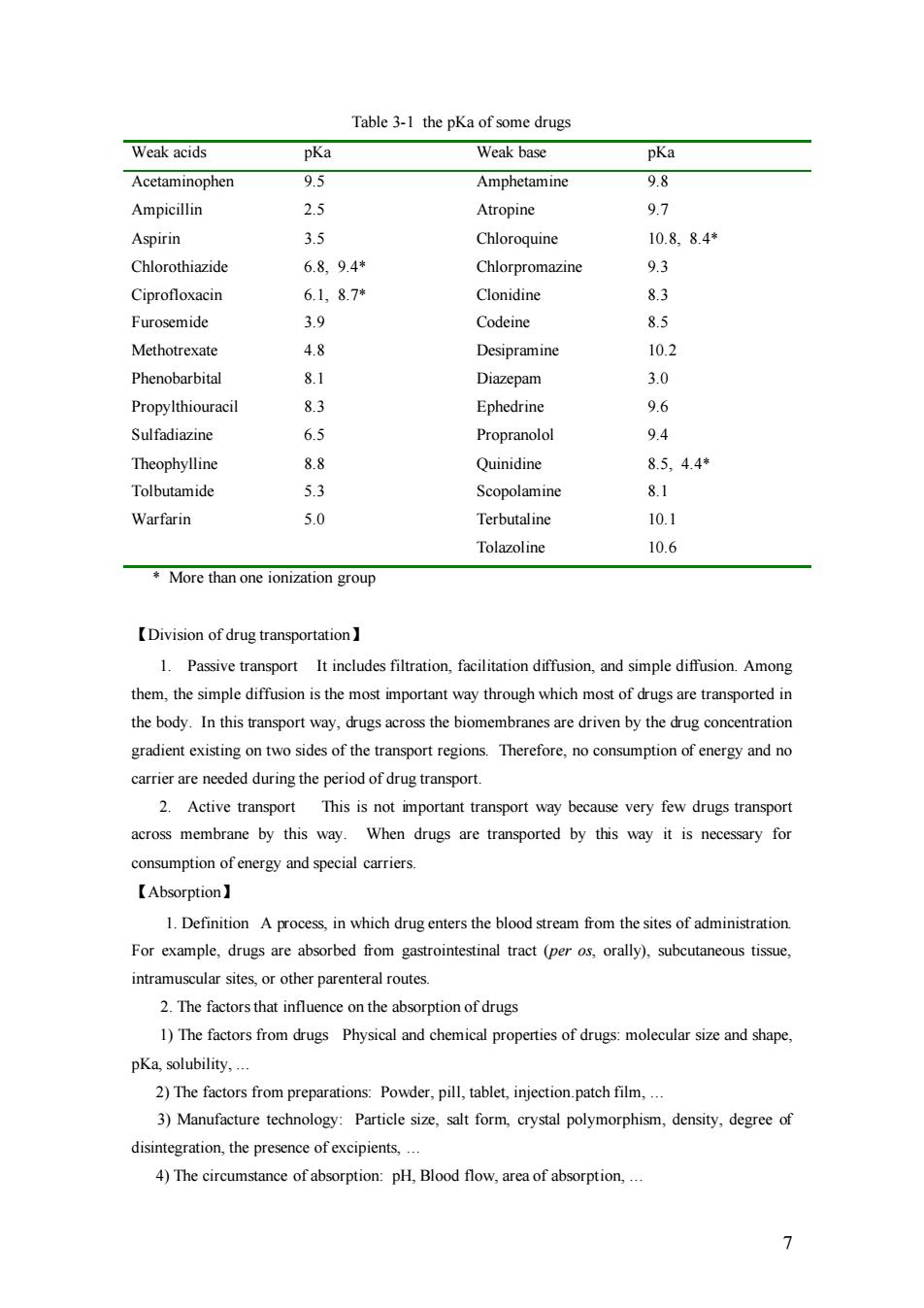
Table 3-1 the pKa of some drugs Weak acids pKa Weak base pKa Acetaminophen 9.5 Amphetamine 9.8 Ampicillin 2.5 Atropine 97 Aspirin 3.5 Chloroquin 10.884* Chlorothiazide 6.8.9.4 Chlorpromazine 9.3 Ciprofloxacin 6.,8.7 Clonidine 83 Furosemide 3.9 Codeine 8.5 Methotrexate 48 Desipramine 10.2 Phenobarbital 8.1 Diazepam 3.0 Propylthiouracil 8.3 Ephedrine 96 Sulfadiazine 65 Propranolol 9.4 Theophylline 8.8 Quinidine 8.5,4.4 Tolbutamide 53 Scopolamine 81 Warfarin 50 Terbutaline 10.1 Tolazoline 10.6 More than one ionization group 【Division of drug transportation】 1.Passive transport It includes filtration.facilitation diffusion.and simple diffusion.Among them.the simple diffusion is the most mportant way through which most in the body.In this transport way,drugs across the biomembranes are driven by the drug concentration gradient existingon two sides of the transport regions.Therefore.no consumption of energy and no carrier are needed during the period of drug transport. 2.Active transport This is not important transport way because very few drugs transport across membrane by this way.When drugs are transported by this way it is necessary for consumption of energy and special carriers 【Absorption】 1.Definition A process,in which drug enters the blood stream from the sites of administration. For example,drugs are absorbed from gastrointestinal tract().subcutaneous tissue. intramuscular sites.or other parenteral routes. 2.The factors that influence on the absorption of drugs 1)The factors from drugs Physical and chemical properties of drugs:molecular size and shape. pKa,solubility, 2)The factors from preparations:Powder,pill,tablet,injection.patchfim, 3)Manufacture technology:Particle size,salt form,crystal polymorphism,density,degree of disintegration,the presence of excipients, 4)The circumstance of absorption:pH,Blood flow,area of absorption
7 Table 3-1 the pKa of some drugs Weak acids pKa Weak base pKa Acetaminophen 9.5 Amphetamine 9.8 Ampicillin 2.5 Atropine 9.7 Aspirin 3.5 Chloroquine 10.8, 8.4* Chlorothiazide 6.8, 9.4* Chlorpromazine 9.3 Ciprofloxacin 6.1, 8.7* Clonidine 8.3 Furosemide 3.9 Codeine 8.5 Methotrexate 4.8 Desipramine 10.2 Phenobarbital 8.1 Diazepam 3.0 Propylthiouracil 8.3 Ephedrine 9.6 Sulfadiazine 6.5 Propranolol 9.4 Theophylline 8.8 Quinidine 8.5, 4.4* Tolbutamide 5.3 Scopolamine 8.1 Warfarin 5.0 Terbutaline 10.1 Tolazoline 10.6 * More than one ionization group 【Division of drug transportation】 1. Passive transport It includes filtration, facilitation diffusion, and simple diffusion. Among them, the simple diffusion is the most important way through which most of drugs are transported in the body. In this transport way, drugs across the biomembranes are driven by the drug concentration gradient existing on two sides of the transport regions. Therefore, no consumption of energy and no carrier are needed during the period of drug transport. 2. Active transport This is not important transport way because very few drugs transport across membrane by this way. When drugs are transported by this way it is necessary for consumption of energy and special carriers. 【Absorption】 1. Definition A process, in which drug enters the blood stream from the sites of administration. For example, drugs are absorbed from gastrointestinal tract (per os, orally), subcutaneous tissue, intramuscular sites, or other parenteral routes. 2. The factors that influence on the absorption of drugs 1) The factors from drugs Physical and chemical properties of drugs: molecular size and shape, pKa, solubility, . 2) The factors from preparations: Powder, pill, tablet, injection.patch film, . 3) Manufacture technology: Particle size, salt form, crystal polymorphism, density, degree of disintegration, the presence of excipients, . 4) The circumstance of absorption: pH, Blood flow, area of absorption,
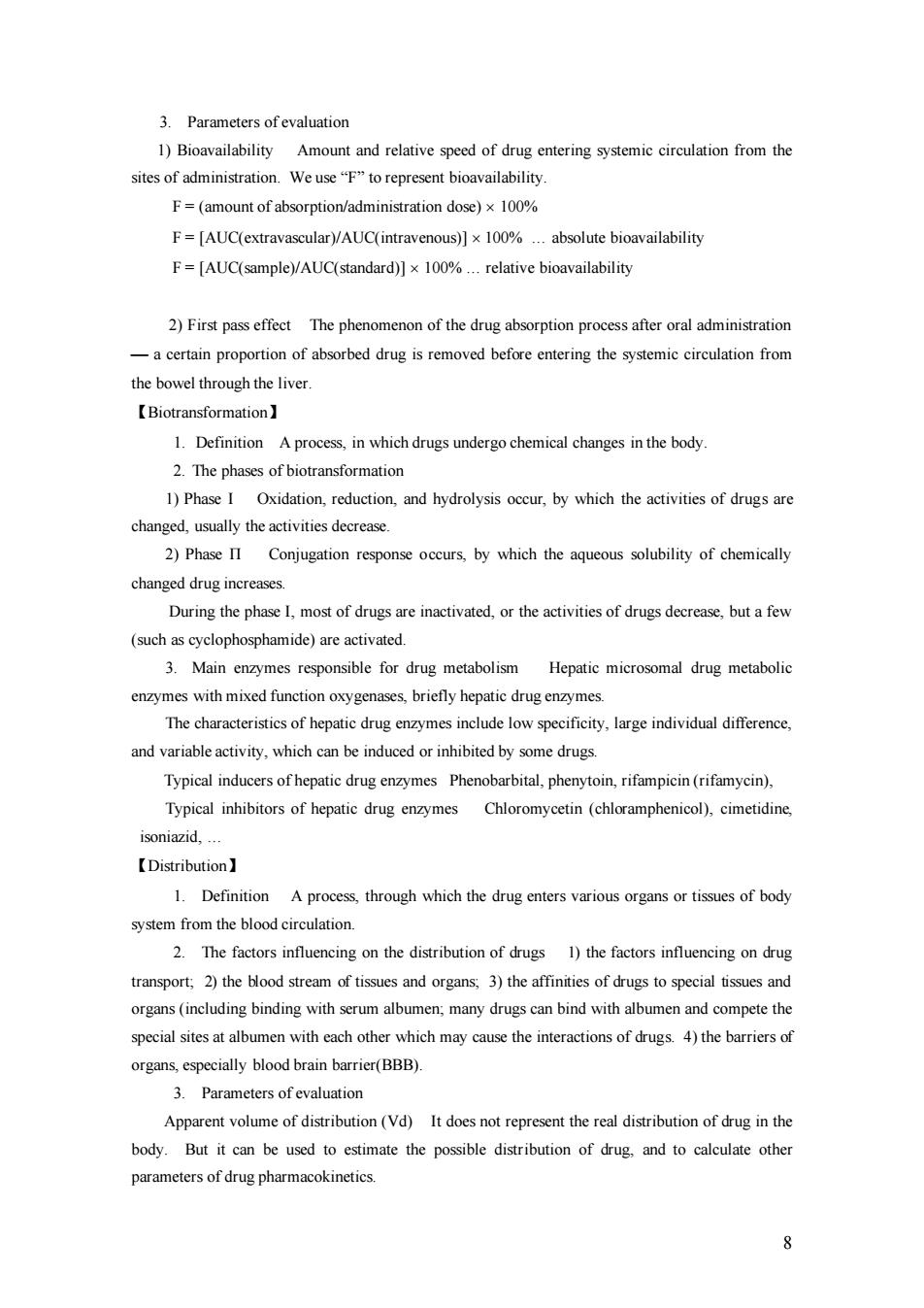
3.Parameters of evaluation 1)Bioavailability Amount and relative speed of drug entering systemic circulation from the sites of administration.Weuse""to represent bioavailability. F=(amount of absorption/administration dose)10 F=[AUC(extravascular)/AUC(intravenous)]x100% F=[AUC(sample)/AUC(standard)]100%.relative bioavailability 2)First pass effect The phenomenon of the drug absorption process after oral administration -a certain proportion of absorbed drug is removed before entering the systemic circulation from the bowel through the live 【Biotransformation】 1.Definition A process,in which drugs undergo chemical changes in the body. 2.The phases of biotransformation 1)Phase I Oxidation,reduction,and hydrolysis occur,by which the activities of drugs are changed,usually the activities decrease 2)Phase II Conjugation response occurs,by which the aqueous solubility of chemically changed drug increases During the phase most of drugs are inactivated,or the activities of drugs decrease,but a few (such as cyclophosphamide)are activated 3.Main enzymes responsible for drug metabolism Hepatic microsomal drug metabolic enzymes with mixed function oxygenases,briefly hepatic drug enzymes. The characteristics of hepatic drug enzymes include low specificity,large individual difference, and variable activity,which can be induced or inhibited by some drugs Typical inducers ofhepatic drug enzymes Phenobarbital,phenytoin,rifampicin(ifamycin), Typical inhibitors of hepatic drug enzymes Chloromycetin (chloramphenicol),cimetidine, isoniazid. 【Distribution】 1.Definition A process,through which the drug enters various organs or tissues of body system from the blood circulation. 2.The factors influencing on the distribution of drugs 1)the factors influencing on drug transport 2)the bood stream of tissues and organs3)the affinities of drugs to special tissues and organs(including binding with serum albumen.many drugs can bind with albumen and compete the special sites at abmen with each other which may cause the interactions of)the barriers of organs,especially blood brain barrier(BBB). 3.Parameters of evaluation Apparent volume of distribution(Vd)It does not represent the real distribution of drug in the body.But it can be used to estimate the possible distribution of drug.and to calculate other parameters of drug pharmacokinetics
8 3. Parameters of evaluation 1) Bioavailability Amount and relative speed of drug entering systemic circulation from the sites of administration. We use “F” to represent bioavailability. F = (amount of absorption/administration dose) 100% F = [AUC(extravascular)/AUC(intravenous)] 100% . absolute bioavailability F = [AUC(sample)/AUC(standard)] 100% . relative bioavailability 2) First pass effect The phenomenon of the drug absorption process after oral administration ⎯ a certain proportion of absorbed drug is removed before entering the systemic circulation from the bowel through the liver. 【Biotransformation】 1. Definition A process, in which drugs undergo chemical changes in the body. 2. The phases of biotransformation 1) Phase Ι Oxidation, reduction, and hydrolysis occur, by which the activities of drugs are changed, usually the activities decrease. 2) Phase Π Conjugation response occurs, by which the aqueous solubility of chemically changed drug increases. During the phase Ι, most of drugs are inactivated, or the activities of drugs decrease, but a few (such as cyclophosphamide) are activated. 3. Main enzymes responsible for drug metabolism Hepatic microsomal drug metabolic enzymes with mixed function oxygenases, briefly hepatic drug enzymes. The characteristics of hepatic drug enzymes include low specificity, large individual difference, and variable activity, which can be induced or inhibited by some drugs. Typical inducers of hepatic drug enzymes Phenobarbital, phenytoin, rifampicin (rifamycin), Typical inhibitors of hepatic drug enzymes Chloromycetin (chloramphenicol), cimetidine, isoniazid, . 【Distribution】 1. Definition A process, through which the drug enters various organs or tissues of body system from the blood circulation. 2. The factors influencing on the distribution of drugs 1) the factors influencing on drug transport; 2) the blood stream of tissues and organs; 3) the affinities of drugs to special tissues and organs (including binding with serum albumen; many drugs can bind with albumen and compete the special sites at albumen with each other which may cause the interactions of drugs. 4) the barriers of organs, especially blood brain barrier(BBB). 3. Parameters of evaluation Apparent volume of distribution (Vd) It does not represent the real distribution of drug in the body. But it can be used to estimate the possible distribution of drug, and to calculate other parameters of drug pharmacokinetics
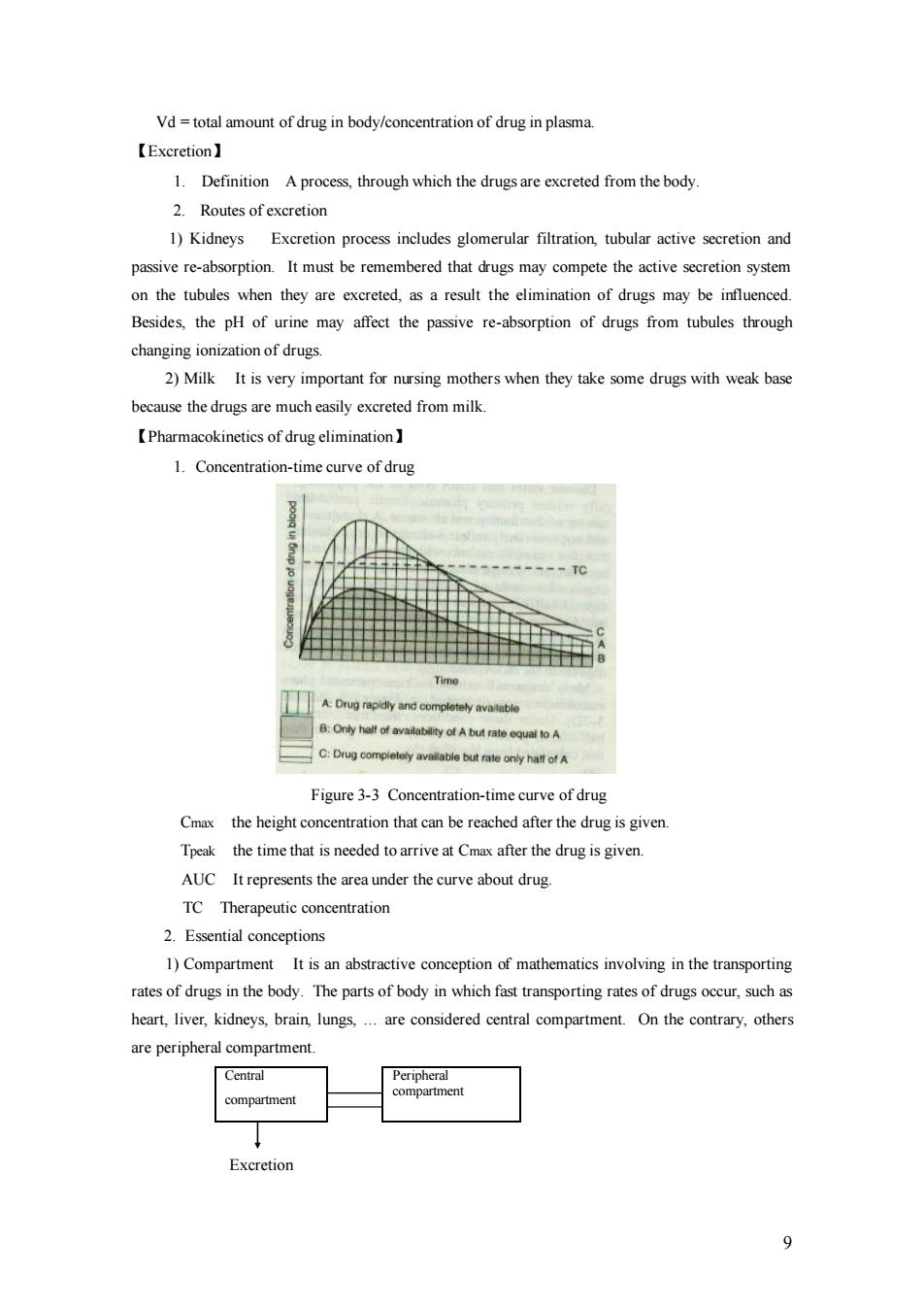
Vd=total amount of drug in body/concentration of drug in plasma 【Excretion】 1.Definition A process.through which the drugs are exereted from the body 2.Routes ofexcretion 1)Kidneys Exeretion process includes tubular active secretion and passive re-absorption.It must be remembered that drugs may compete the active secretion system on the tubules when they are excreted.as a result of drugs may be Besides,the pH of urine may affect the passive re-absorption of drugs from tubules through changing ionization of drugs 2)Milk It is very important for nursing mothers when they take some drugs with weak base because the drugs are much easily excreted from milk. 【Pharmacokinetics of drug elimination】 1.Concentration-time curve of drug C Drug competely avb but rate onyhatl ofA Figure 3-3 Concentration-time curve of drug Cmax the height concentration that can be reached after the drug is given. Tpeak the time that is needed torrive t Cm after the drug is given AUC It represents the area under the curve about drug. TC Therapeutic concentration 2.Essential conceptions 1)Compartment It is an abstractive conception of mathematics involving in the transporting rates of drugs in the body.The parts of body in which fast transporting rates of drugs occur,such as heart,liver,kidneys,brain lungs,are considered central compartment.On the contrary,others are peripheral compartment. Central compartment ↓ Excretion 9
9 Vd = total amount of drug in body/concentration of drug in plasma. 【Excretion】 1. Definition A process, through which the drugs are excreted from the body. 2. Routes of excretion 1) Kidneys Excretion process includes glomerular filtration, tubular active secretion and passive re-absorption. It must be remembered that drugs may compete the active secretion system on the tubules when they are excreted, as a result the elimination of drugs may be influenced. Besides, the pH of urine may affect the passive re-absorption of drugs from tubules through changing ionization of drugs. 2) Milk It is very important for nursing mothers when they take some drugs with weak base because the drugs are much easily excreted from milk. 【Pharmacokinetics of drug elimination】 1. Concentration-time curve of drug Figure 3-3 Concentration-time curve of drug Cmax the height concentration that can be reached after the drug is given. Tpeak the time that is needed to arrive at Cmax after the drug is given. AUC It represents the area under the curve about drug. TC Therapeutic concentration 2. Essential conceptions 1) Compartment It is an abstractive conception of mathematics involving in the transporting rates of drugs in the body. The parts of body in which fast transporting rates of drugs occur, such as heart, liver, kidneys, brain, lungs, . are considered central compartment. On the contrary, others are peripheral compartment. Excretion Central compartment Peripheral compartment
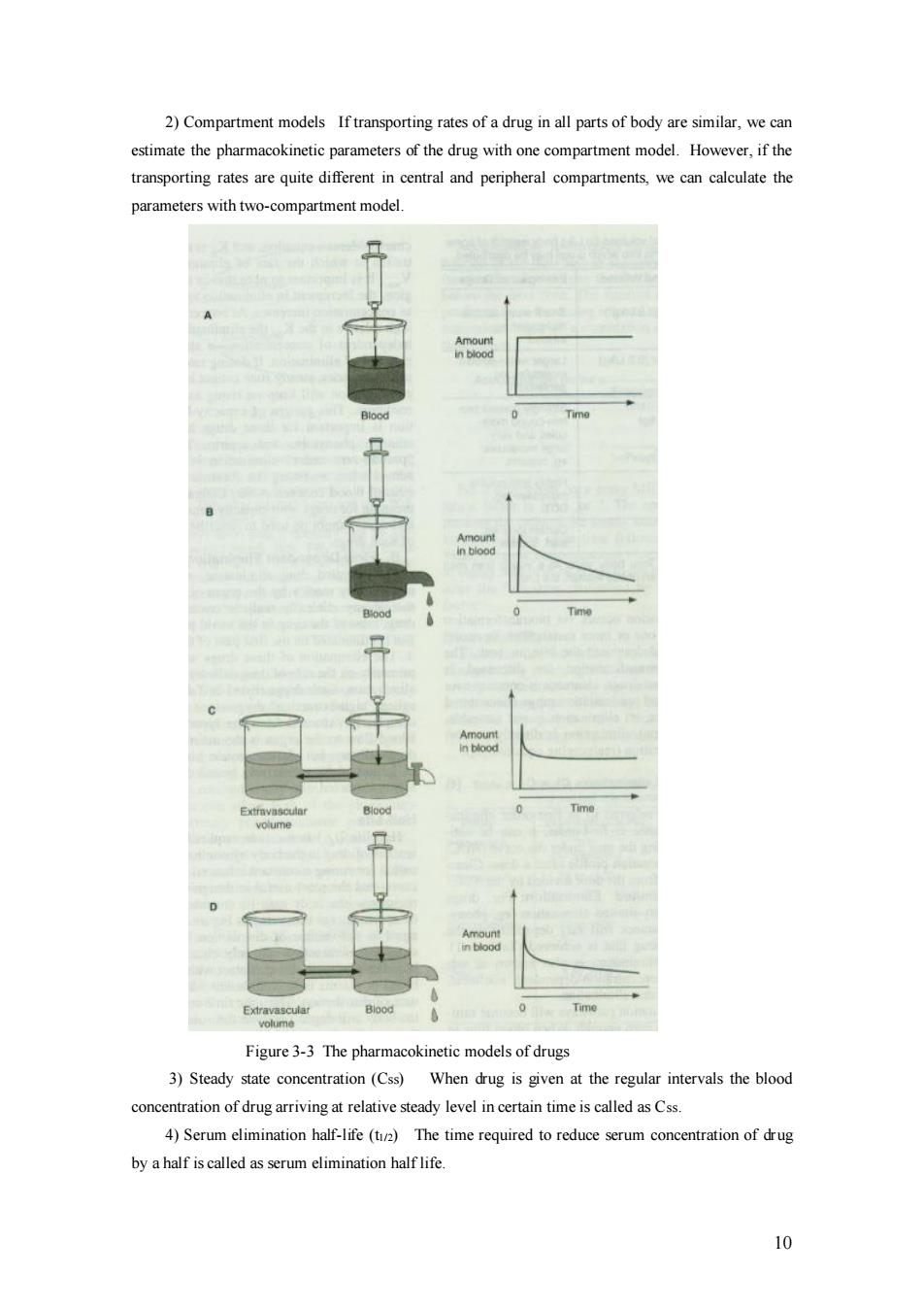
2)Compartment models If transporting rates of a drug in all parts of body are similar,we can estimate the pharmacokinetic parameters of the drug with one compartment model.However,if the transporting rates are quite different in central and peripheral compartments,we can calculate the parameters with two-compartment model. Time Figure 3-3 The pharmacokinetic models of drugs 3)Steady state concentration(Css)When drug is given at the regular intervals the blood concentration of drug arriving at relative steady level in certain time is called as Css. 4)Serum elimination half-life (The time required to reduce serum concentration ofrug by a half is called as serum elimination half life
10 2) Compartment models If transporting rates of a drug in all parts of body are similar, we can estimate the pharmacokinetic parameters of the drug with one compartment model. However, if the transporting rates are quite different in central and peripheral compartments, we can calculate the parameters with two-compartment model. Figure 3-3 The pharmacokinetic models of drugs 3) Steady state concentration (Css) When drug is given at the regular intervals the blood concentration of drug arriving at relative steady level in certain time is called as Css. 4) Serum elimination half-life (t1/2) The time required to reduce serum concentration of drug by a half is called as serum elimination half life